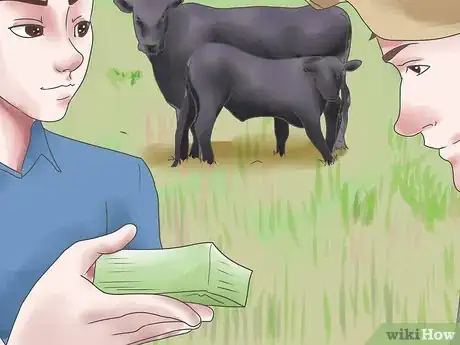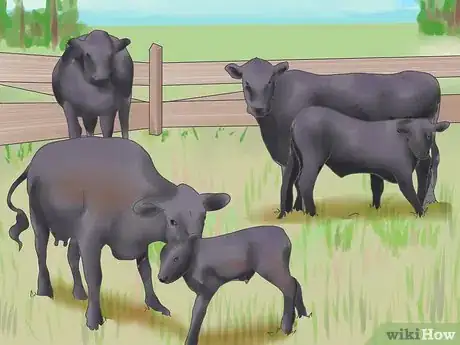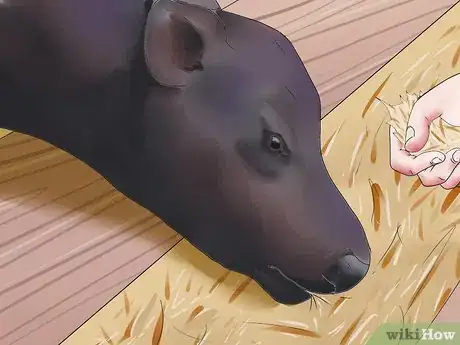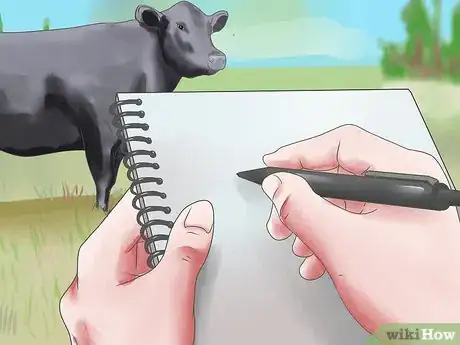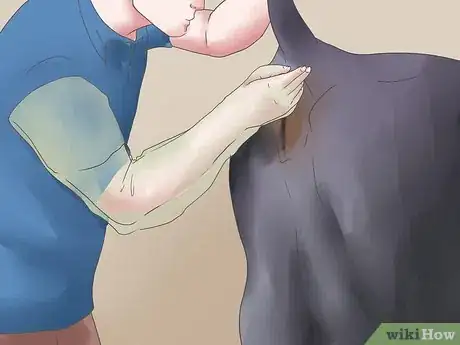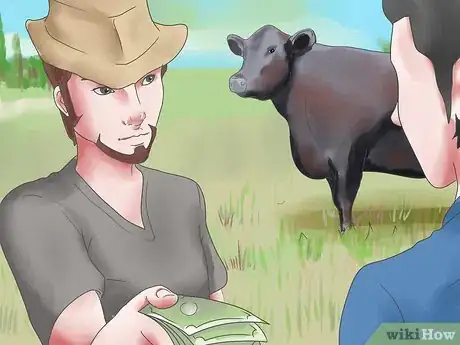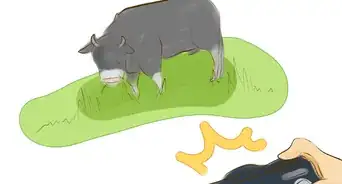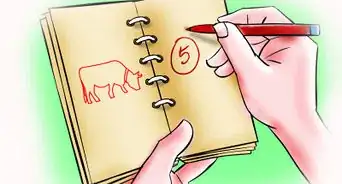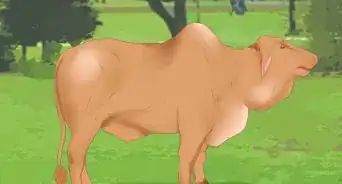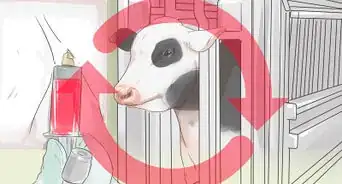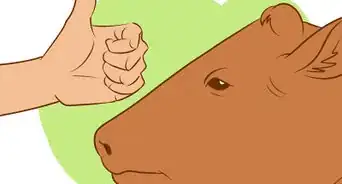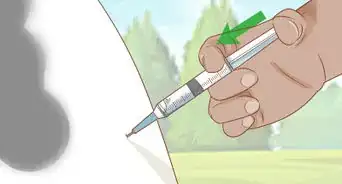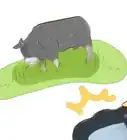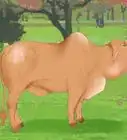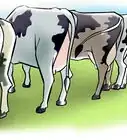This article was co-authored by Karin Lindquist. Karin Lindquist earned a BSc in Agriculture as an Animal Science major from the University of Alberta, Canada. She has over 20 years of experience working with cattle and crops. She's worked for a mixed-practice veterinarian, as a sales representative in a farm supply store, and as a research assistant doing rangeland, soil, and crop research. She currently works as a forage and beef agriculture extension specialist, advising farmers on a variety of issues relating to their cattle and the forages they grow and harvest.
There are 9 references cited in this article, which can be found at the bottom of the page.
wikiHow marks an article as reader-approved once it receives enough positive feedback. In this case, 91% of readers who voted found the article helpful, earning it our reader-approved status.
This article has been viewed 274,716 times.
Black Angus or Angus cattle are beef cattle that can be raised in a variety of conditions, from on a ranch where the cattle have to pretty well look after themselves, to the feedlot. Each individual producer has his/her own way to raise Angus cattle, and none of them are the same. So only the basics are given for an Angus cow-calf herd, not for finishing or backgrounding cattle. The more finite details of how you choose to raise your Angus herd is up to you.
Steps
-
1Buy and start up your Angus herd and choose the Angus cattle you need for the operation you are managing.
-
2From your business plan created before you started up your ranch, carry through with when you want to have your calving, breeding and weaning seasons. Depending on your operation, you may wish to time your reproductive seasons with how Nature works, or work against it to time it with other markets like selling bulls and heifers when they're a year old, or to time it with the spring markets.
- Have your calving season during a time that you can handle calving and manage calving cows and calves all at the same time when risking adverse weather conditions.
- Calving management is crucial to ensure high calf survival from birth to when you sell them. During the calving season, cows and heifers should be monitored for any signs of dystocia or calving issues, and calves for any signs of cold stress, scours, injuries, pneumonia, or any other health issue. Calving out on pasture will minimize any scours, however calving in springtime can be a problem because of the risk of April snow storms that may occur, especially if you live near the Rockies or in areas where spring snowstorms will almost always occur in the springtime. Having adequate shelter, good bedding and plenty of feed is important during this busy time of year.
- Know when a cow or heifer is ready to give birth. This is important in telling when and whether a female is going to be needing assistance or not.
- Be prepared with the necessary equipment for dealing with dystocia or health or injury-related issues.[1] Your large-animal veterinarian's phone number should be on hand as well.
- Separate heavily pregnant cows from cows that have calved. It's easier to separate the heavily pregnant cows into a new pasture than it is vice versa. This is so that those cows that are ready to calve out won't be stealing another cow's calf. This occurs occasionally when hormones are raging during this busy time of year.
-
Breeding season should follow a few months (80 to 90 days) after calving, and last 45 to 60 days long to ensure fertility in the herd. It should coincide with your calving schedule so that you are calving out your cows and heifers the same time every year without any discrepancies.
- Breeding management needs consideration. Will you be breeding your cows using artificial insemination (AI), or natural breeding, or both?
- If breeding your cows naturally, choose a good Angus herd bull that will improve the genetic merit of your herd.
- If you are wanting to breed your cows using AI, choose superior proven Angus sires with the EPDs (Expected Progeny Differences) that will improve your cow herd. A clean-up bull is good to have to make sure all cows are serviced in time for calving season.
- It is highly recommended you semen test all of your bulls prior to breeding season. Nothing is worse than finding out that the main reason you had a lot more open cows than usual was because the bull or bulls you were using was or were shooting blanks, or had a reproductive injury (broken penis) or abnormality (corkscrew penis or abnormal sperm production) that was not caught at sale day.
- Breeding management needs consideration. Will you be breeding your cows using artificial insemination (AI), or natural breeding, or both?
-
Weaning should take place when the calves reach 6 to 8 months of age.
- Preconditioning calves prior to weaning will minimize stress for the calves at weaning time.
- It's also recommend to wean and sell calves when the market price is high, not when its low.
Advertisement -
3Health Management. Unless you have an extremely closed herd (nobody and nothing coming in to your herd from other herds, biosecurity, etc.), herd health management is important for the health of your cows and calves. Annual or biannual vaccination program for your calves, bulls and cows needs to be implemented to keep your herd healthy. See your veterinarian for an accurate herd health program for your herd.[2]
- The most important vaccinations for your herd include 8-way or 9-way Clostridium vaccine, and vaccines for BRSV, BRD, PI3, IBR, and Lepto. Some areas may require a vaccine for anthrax as well, if you are in an area that has historically had problems with anthrax outbreaks.
- It's best to vaccinate cows at least 3 weeks before calves are born to minimize having to vaccinate calves when you have to tag and castrate them.
-
4Feeding Management. This is very important to your herd. You can't have cows without having something available they can eat. Use the time from spring to fall to make hay, silage and/or grain for your cattle. Make sure you have enough land to make the feed for all animals combined, and that you know the average rate of intake of your cowherd and your bulls. Sometimes you may have to buy feed, but most produces like to shy away from that and put efforts in to produce their own forage.[3]
- Feed your cows according to their nutritional demands during their reproductive stages. For instance, a cow ingests 50% more when lactating than when she's dry.[4]
Feed that is high in calcium and protein is important to maintain good milk production. When she's dry (with no calf at side), lower intake and lower nutrition is optimum for her, but enough so that she doesn't lose weight nor starves on feed that is just gut-filler.
- All cattle typically eat 2.5% of their body weight of dry matter ration. Lactating cows will eat around 3.5% to 4% of their body weight in dry matter ration. How much cattle eat on an as-fed basis ultimately depends on the moisture content of the feed.
- Feed your cows according to their nutritional demands during their reproductive stages. For instance, a cow ingests 50% more when lactating than when she's dry.[4]
Feed that is high in calcium and protein is important to maintain good milk production. When she's dry (with no calf at side), lower intake and lower nutrition is optimum for her, but enough so that she doesn't lose weight nor starves on feed that is just gut-filler.
-
5Pasture Management. Know, according to where you are located and what type of operation you have, when the best time is to let cows out on pasture and when the right time is to switch pastures. Unless you are doing MIG or rotational grazing, it's best to graze your cows so that you can rotate them once every one to three weeks, allowing the pasture to rest for at least 30 days.[5]
- Do not let your pastures get overgrazed.[6]
The more a herd of cows graze a particular spot, the less productive it will be. Rotational grazing (or Managed Intensive Grazing) is a good management practice to consider if you wish to keep your grass and pastures as uniform and healthy as possible.
- Knowing your stocking rates, stocking density and carrying capacity for your area will definitely help you in determining how many cows per acre (or acres per cow) is needed to stock your pastures.
- AU means Animal Units, where one 1000 lb cow (with or without a calf) will consume around 25 lbs of grass per day. AUD is the amount of forage that an animal unit will consume in one day; AUM is the amount of forage that an animal unit will consume in one month.
- Visit your local agricultural extension office (USA) or government of agriculture office (Canada) to get information on the stocking rate, stocking density and carrying capacity of your area.
- AU means Animal Units, where one 1000 lb cow (with or without a calf) will consume around 25 lbs of grass per day. AUD is the amount of forage that an animal unit will consume in one day; AUM is the amount of forage that an animal unit will consume in one month.
- Knowing your stocking rates, stocking density and carrying capacity for your area will definitely help you in determining how many cows per acre (or acres per cow) is needed to stock your pastures.
- Match grass quality with the animals you have, or what nutritive levels they're at. High quality pastures should be reserved for lactating cows and growing feeder/stocker calves and even bulls that need to improve their condition. Low quality pastures are for dry pregnant cows, cows that have just been weaned from their calves, or cows that have calves 3 months of age or older.
- Keep an eye out for anti-quality factors such as bloat, nitrate toxicity, grass tetany, and fescue toxicity. Manage your pastures and your Angus cattle to avoid such anti-quality factors from occurring in your herd.
- Do not let your pastures get overgrazed.[6]
The more a herd of cows graze a particular spot, the less productive it will be. Rotational grazing (or Managed Intensive Grazing) is a good management practice to consider if you wish to keep your grass and pastures as uniform and healthy as possible.
-
6Record keeping. Keep records of everything from calving to breeding to health and feeding/pasture management. You never know when you may need them. Keeping record of your finances will also help you immensely in the long-run.[7]
-
7Cull those cows and bulls that are pulling your herd down. Cull for temperament, health, conformation, ability to raise and care for a calf, fertility, and forage convertibility.[8]
- Pregnancy-checking your females will help in determining whether some of your cows are open or not. Rectal palpation is the cheapest and often quickest way to preg-check your cows and heifers.
- Body condition scoring your cattle will also help in determining which cows should be kept or not. It also tells you which cows are too thin to calve or to go into winter and which need more higher quality feed in the winter than others.
-
8Sell your calves come fall or spring, whichever market you choose to target.[9]
Community Q&A
-
QuestionWhat is the gestation period?
 Community AnswerGestation period is the length a female is pregnant with young. For cows, it's an average of 285 days, or 9.5 months.
Community AnswerGestation period is the length a female is pregnant with young. For cows, it's an average of 285 days, or 9.5 months. -
QuestionHow much should I feed replacement heifers?
 Community AnswerFigure 2.5% of their body weight in dry matter feed per day. That's dry matter, with all the moisture taken out. Be sure to feed them so that they are not getting overly fat, but have a good body condition. Average daily gain should not exceed 1.5 to 2 pounds per day. Watch grain intake (if supplementing with grain) as well as the quality of feed. Feed can be too high in quality, causing too much weight gain, and too much fat deposition. Please talk to a beef nutritionist for advice on feeding your heifers.
Community AnswerFigure 2.5% of their body weight in dry matter feed per day. That's dry matter, with all the moisture taken out. Be sure to feed them so that they are not getting overly fat, but have a good body condition. Average daily gain should not exceed 1.5 to 2 pounds per day. Watch grain intake (if supplementing with grain) as well as the quality of feed. Feed can be too high in quality, causing too much weight gain, and too much fat deposition. Please talk to a beef nutritionist for advice on feeding your heifers. -
QuestionWhat feed do cows eat?
 KarinTop AnswererThey eat hay, pasture, silage, and grain.
KarinTop AnswererThey eat hay, pasture, silage, and grain.
Warnings
- Angus cattle are very popular in North America, and there's a high degree of probability that the cattle you are looking for aren't the ones for you. With that in mind, you need to be very picky to get the animals you want for your Angus herd.⧼thumbs_response⧽
- Be wary around bulls. Never trust them, and never turn your back on them, but never show your fear around them, as that is often a sign of weakness and will often result in having a bull getting a bit testy around you.
- This can be easier said than done!
⧼thumbs_response⧽ - Angus cattle can be quite "fun" to work with. There will be certain bloodlines of Angus cattle that are very skittish and wild (the EXT bloodline is one to definitely stay away from!!), and other bloodlines from farms and ranches with Angus cattle that are really docile. Avoid the wild ornery ones if at all possible.
- If you get cows that end up being quite cranky all the time, cull them. It's not worth your life keeping crazy cows around, even if they raise a darn good calf.
⧼thumbs_response⧽
References
- ↑ https://www.nadis.org.uk/disease-a-z/cattle/calving-module/calving-part-2-calving-problems-dystocia/
- ↑ https://extension.tennessee.edu/Sullivan/Documents/Ag%20Documents/Master%20Beef%20Producer%20Lessons/Chapter%2008%20-%20Health%20Management%20of%20Beef%20Cattle%20%5BRead-Only%5D%20%5BCompatibility%20Mode%5D.pdf
- ↑ https://www.nrcs.usda.gov/Internet/FSE_DOCUMENTS/stelprdb1044378.pdf
- ↑ https://www.dpi.nsw.gov.au/__data/assets/pdf_file/0019/96202/full-hand-feeding-of-beef-cattle-quantities.pdf
- ↑ https://cefs.ncsu.edu/extension-and-outreach/amazing-grazing/
- ↑ https://extension.psu.edu/avoid-overgrazing-your-pastures
- ↑ https://www.beefmagazine.com/americancowman/in-the-spotlight/record_keeping
- ↑ https://www.beefmagazine.com/blog/9-things-consider-culling-cow
- ↑ https://www.beefmagazine.com/blog/how-receive-full-value-your-calves
